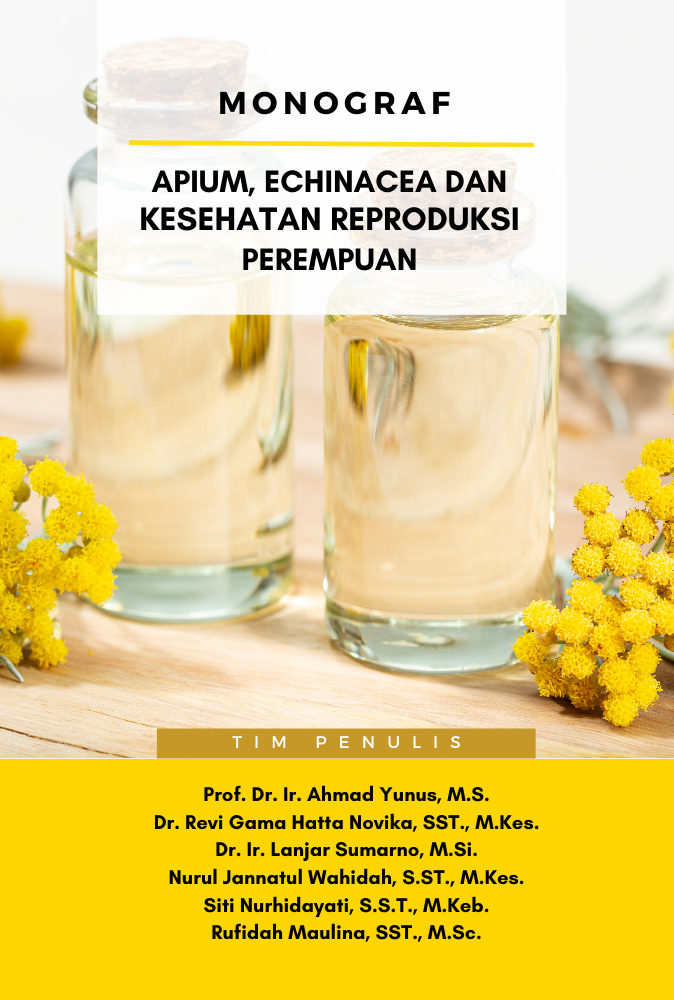Apium, Echinachea, dan Kesehatan Reproduksi Perempuan
Synopsis
Tubuh manusia secara terus-menerus melawan invasi dari bakteria dan virus yang ada di sekitar kita. Patogen tersebut dapat masuk ke dalam tubuh melalui jaringan kulit yang terluka maupun mukosa yang ada di saluran pencernaan ataupun pernapasan. Agar dapat bertahan hidup, yaitu dengan membentuk sel-sel imun. Sel-sel ini berbeda dengan sel lain dalam tubuh karena memiliki kemampuan untuk melakukan beberapa aktivitas seperti fagositosis, pembentukan sitokin dan pergerakan ke jaringan yang mengalami inflamasi. Imunologi mempelajari bagaimana sistem imun bekerja dalam tubuh baik itu berkaitan dengannya sebagai pertahanan terhadap infeksi maupun pada kondisi lainnya.
Imunitas terutama berkaitan dengan pertahanan tubuh terhadap penyakit-penyakit menular. Sel, jaringan, dan molekul di dalam tubuh yang saling bekerja sama untuk menciptakan pertahanan terhadap infeksi dari luar tubuh disebut dengan sistem kekebalan tubuh. Sementara itu, reaksi yang terkoordinasi antara sel, jaringan, dan molekul di dalam tubuh terhadap infeksi dari luar tubuh disebut dengan respons imun. Selanjutnya, ilmu yang mempelajari sistem kekebalan tubuh dan respons imun disebut dengan imunologi.
ISBN: 978-623-5431-83-3
Referensi:
Ait-Ouazzou, A., Lorán, S., Bakkali, M., Laglaoui, A., Rota, C., Herrera, A., Pagan, R., & Conchello, P. (2011). Chemical composition and antimicrobial activity of essential oils of Thymus algeriensis, Eucalyptus globulus and Rosmarinus officinalis from Morocco. J Sci Food Agric, 91(14), 2643-51. [http://dx.doi.org/10.1002/jsfa.4505] [PMID: 21769875]
Arifin, P. F., Assa, T. I. Y., Nora, A., & Wisastra, R. (2022). Evaluating the Antioxidant Activity of Ethanol Extract from Echinacea purpurea ( L .) Moench. 6(2), 39–44.
Atta, A., & Alkofahi, A. (1998). Anti-nociceptive and anti-inflammatory effects of some Jordanian medicinal plant extracts. Journal of ethnopharmacology. 60(2), 117-124.
Barnes, J., Anderson, L,A., Gibbons, S., Phillipson, J,D. (2005). Echinacea species (Echinacea angustifolia (DC.) Hell., Echinacea pallida (Nutt.) Nutt., Echinacea purpurea (L.) Moench): A review of their chemistry, pharmacology and clinical properties. J Pharm Pharmacol, 57, 929‑54.
Cabi.org. (2019). Echinacea purpurea (purple coneflower). Taken from https://www.cabi.org/isc/datasheet/48033
Cassano, M., & Dufour, J.F. (2018). Inflammation and microbiota fingerprint: delphi’s oracle for NAFLD-related HCC?. Hepatology, 69, 12–15.
Catalog of Life: 2019 Annual Checklist. 2019. Eucalyptus globulus Labill. Taken from: https://www.catalogueoflife.org/data/taxon/3BPZ6
Cseke, L,J., Kirakosyan, A., Kaufman, P.B., Warber, S., Duke, J.A., & Brielmann, H.L. (2016). Natural products from plants. CRC press: pp.
Dalby‐Brown, L., Barsett, H., Landbo, A,K., Meyer, A,S., dan Mølgaard, P. (2005). Synergistic antioxidative effects of alkamides, caffeic acid derivatives, and polysaccharide fractions from Echinacea purpureaon in vitro oxidation of human low‐density lipoproteins. Journal of Agricultural Food Chemistry, 53, 9413‐9423.
Dixit, A., Rohilla, A., & Singh, V. (2012). Eucalyptus globulus: A new perspective in therapeutics. Int J Pharm Chem Sci, 1(4), 1678-83.
Emara, S., & Shalaby, A,E. (2011). Seasonal variation of fixed and volatile oil percentage of four Eucalyptus spp. related to lamina anatomy. Afr J Plant Sci, 5(6), 353-9.
Fazal, S,S., & Singla, R.K. (2005). Review on the Pharmacognostical & Pharmacological Characterization of Apium Graveolens Linn. Indo Global Journal of Pharmaceutical Sciences, 2(1), 36-42.
Gajalakshmi, S., Vijayalakshmi, S., & Devirajeswari, V. (2012). Echinacea purpurea - A potent immunostimulant. International Journal of Pharmaceutical Sciences Review and Research, 14(2), 47–52.
Guzmán, P., Fernández, V., Graça, J., Cabral, V., Kayali, N., Khayet, M., & Gil, L. (2014). Chemical and structural analysis of Eucalyptus globulus and E. camaldulensis leaf cuticles: A lipidized cell wall region. Frontiers in Plant Science, 5(SEP), 1–12. https://doi.org/10.3389/fpls.2014.00481.
Hasegawa, T., Takano, F., Takata, T., Niiyama, M., & Ohta, T. (2008). Bioactive monoterpene glycosides conjugated with gallic acid from the leaves of Eucalyptus globulus. Phytochemistry, 69(3), 747-53. [http://dx.doi.org/10.1016/j.phytochem.2007.08.030] [PMID: 17936865]
Hassan, F., Bazaid, S., & Ali, E. (2013). Effect of deficit irrigation on growth, yield and volatile oil content on Rosmarinus officinalis. L. plant. J. Med. Plant. Stud, 1(3), 12- 21.
Hayat, U., Jilani, M. I., Rehman, R., & Nadeem, F. (2015). A Review on Eucalyptus globulus: A New Perspective in Therapeutics. International Journal of Chemical and Biochemical Sciences, 8(January 2015), 85–91.
https://en.journalmural.com/eucalyptus-globulus-caracter-sticas
https://www.ncbi.nlm.nih.gov/Taxonomy/Browser/wwwtax.cgi?mode=Info&id=53751
Juergens, U,R., Stöber, M., & Vetter, H. (1998). Inhibition of cytokine production and arachidonic acid metabolism by eucalyptol (1.8-cineole) in human blood monocytes in vitro. Eur J Med Res, 3(11), 508-10. [PMID: 9810029]
Khalil, A., Nawaz, H., Ben Ghania, J., Rehman, R., & Nadeem, F. (2015). Value Added Products, Chemical Constituents and Medicinal Uses of Celery (Apium graveolens L.)-A Review. International Journal of Chemical and Biochemical Sciences. University of Agriculture, 8, 40–48.
Kooti, W., & Daraei, N. (2017). A Review of the Antioxidant Activity of Celery (Apium graveolens L). Journal of Evidence-Based Complementary and Alternative Medicine, 22(4), 1029–1034. https://doi.org/10.1177/2156587217717415
Lin, S.D., Sung, J.M. and Chen, C.L. (2011). Effect of Drying and Storage Conditions on Caffeic Acid Derivatives and total Phenolics of Echinacea purpurea Grown in Taiwan. Food Chemistry, 125, 226-231.
Manayi, A., Vazirian, M., & Saeidnia, S. (2015). Echinacea purpurea: Pharmacology, phytochemistry and analysis methods. Pharmacognosy Reviews, 9(17), 63–72. https://doi.org/10.4103/0973-7847.156353
Ma'rifah, A., & Suryantini, N. P. (2022). JOMBANG NURSING AND MIDWIFERY JOURNAL A APIUM GRAVEOLENS L EXTRACT : Alternative Complementary Therapies to Decrease Hypertension. 1(1), 15–21.
Melo, E,A., Filho, J,M., & Guerra, N, B. (2005). Characterization of antioxidant compounds in aqueous coriander extracts (Coriander sativum L.). LWT-Food Sci Technol, 38,15-19.
Nagoor Meeran, M. F., Javed, H., Sharma, C., Goyal, S. N., Kumar, S., Jha, N. K., & Ojha, S. (2021). Can Echinacea be a potential candidate to target immunity, inflammation, and infection - The trinity of coronavirus disease 2019. Heliyon, 7(2), e05990. https://doi.org/10.1016/j.heliyon.2021.e05990
Pellati, F., Benvenuti, S., Margo, L., Melegari, M., & Soragni, F. (2004). Analysis of phenolic compounds and radical scavenging activity of Echinacea species. Journacy of Pharmacy and Biomedical Analysis, 35(2), 289‐301.
Puig, C. G., Reigosa, M. J., Valentão, P., Andrade, P. B., & Pedrol, N. (2018). Unravelling the bioherbicide potential of Eucalyptus globulus Labill: Biochemistry and effects of its aqueous extract. PLoS ONE, 13(2), 1–16. https://doi.org/10.1371/journal.pone.0192872
Serafino, A, Sinibaldi Vallebona, P., Andreola, F., Zonfrillo, M., Mercuri, L., Federici, M., Rasi, G., Garaci, E., Pierimarchi, P. (2008). Stimulatory effect of Eucalyptus essential oil on innate cell-mediated immune response. BMC Immunol, 9, 17. [http://dx.doi.org/10.1186/1471-2172-9-17] [PMID: 18423004]
Sowbhagya, H. (2014). Chemistry, technology, and nutraceutical functions of celery (Apium graveolensL.): an overview. Critical reviews in food science and nutrition, 54(3), 389-398.
Spelman, K., Wetschler, M,H., dan Cech, N,B. (2009). Comparison of alkamide yield in ethanolic extracts prepared from fresh versus dry Echinacea purpurea utilizing HPLC‐ESI‐MS. Journal of Pharmacy and Biomedical Analysis, 49(5), 1141‐1149.
Teng, C,M., Lee, L,G., & Ko, S,N. (1985). Inhibition of platelet aggregation by apigenin from Apium graveolens. As. Pac. J. Pharmacol. 83: 85.
Tsi, D., & Tan, B,K,H. (1997). Cardiovascular pharmacology of 3-nbutylphthalide in spontaneously hypertensive rats. Phytother. Res, 11, 576-582.
Vecchio, M. G., Loganes, C., & Minto, C. (2016). Beneficial and Healthy Properties of Eucalyptus Plants: A Great Potential Use. The Open Agriculture Journal, 10(1), 52–57. https://doi.org/10.2174/1874331501610010052

Forthcoming
Series
License

This work is licensed under a Creative Commons Attribution-NonCommercial-ShareAlike 4.0 International License.

















